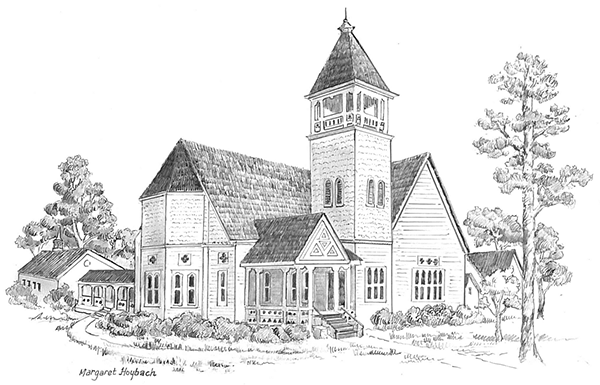In October 1695, in response to letters received from the people of Carolina requesting spiritual guidance, the people of Dorchester, Massachusetts organized a church with the descendants of the original English immigrants, “to go to Carolina and settle the gospel there.” On December 14, 1695, the Rev. Joseph Lord and his followers, sailed at midnight in two boats. They encountered a tremendous storm and one ship, the “Skiff,” nearly capsized. After a day of fasting and prayer, they arrived, having taken fourteen days journey from Massachusetts to Carolina. When they arrived, they fired three guns, announcing their arrival to the people of Carolina. Anticipating this arrival, the people of Carolina fired nine guns, “which was more than usual.”
A site, eighteen miles from Charleston, was chosen and named Dorchester, again, to honor their roots. In February, under the branches of an oak tree, they took the first Sacrament of the Lord’s Supper and named their church, The Independent White Church, possibly after John White, the “Patriarch of Dorchester.” The church became known as the Old White Meeting House. A wood church was first built. This structure was later followed by the construction of a brick building whose remnants can still be seen.
For nearly 52 years services were held in the Old White Meeting House; however, in 1752 the people of Dorchester migrated to Georgia. The migration was due to the fact that they needed more land. They settled in Midway, Georgia, an area which has since been a center of Presbyterian influence.
Throughout the Revolutionary War, the British occupied the church building and when they withdrew, burned its interior. The walls were all that remained. The interior was rebuilt and on July 19, 1794, for the first time since the end of the Revolutionary War in 1783, the United Independent Congregational Church of Dorchester and Beech Hill held worship. Services were then held alternately in the Dorchester and Beech Hill Churches. The Beech Hill Church was located in the Parish of St. Paul. Unfortunately, nothing now remains of that church having long ago fallen into disrepair.
On February 22, 1846, Rev. George Sheldon observed the 150th anniversary of the building of the Old White Meeting House. With Rev. Sheldon’s resignation later that year, fewer services were held in the Old White Meeting House and interest in a Summerville Church began. Construction of “Summer Church” began in 1831. The supporters of Dorchester Church met in March of 1859 to ask the Charleston Presbytery to organize the Summerville Presbyterian Church. The Presbytery met on June 9, 1859 and chartered Summerville Presbyterian Church. By 1886, all that remained of the Old White Meeting House were its exterior walls, which were almost leveled by the earthquake of that year. By 1894, the 1831 building was in disrepair and the sixty-six members undertook the formidable task of building our present sanctuary which was dedicated in 1895.
From Dorchester, England to Dorchester, Massachusetts to Dorchester, South Carolina to Summerville, the history of the congregation of Summerville Presbyterian Church spans four centuries. May our congregation continue to grow and serve God for centuries to come.
Contact Us
Please feel free to contact us
(843) 871-0280
[email protected]
407 South Laurel Street, Summerville, SC 29483Get Our Newsletter
Copyright 2023 | Login

